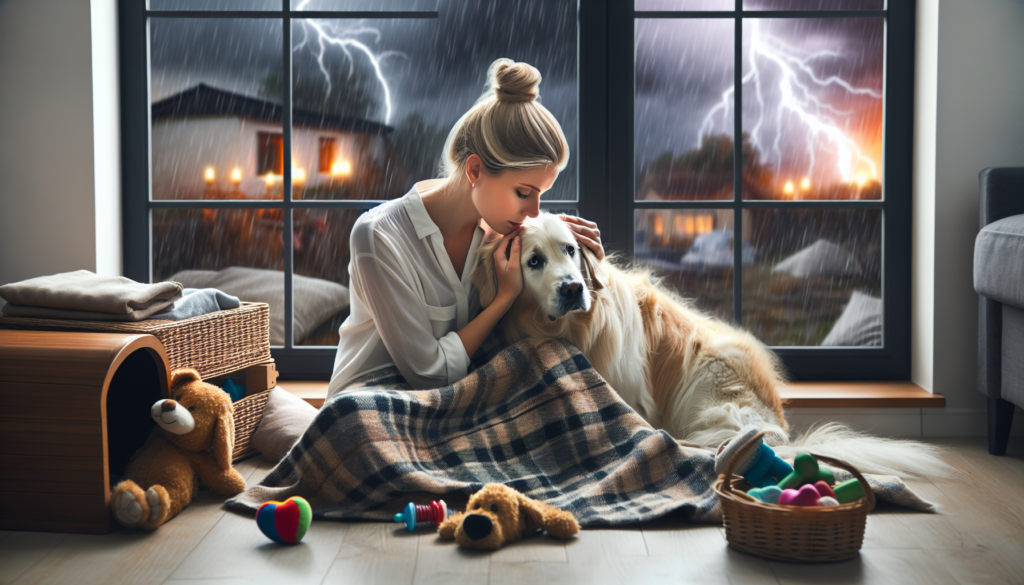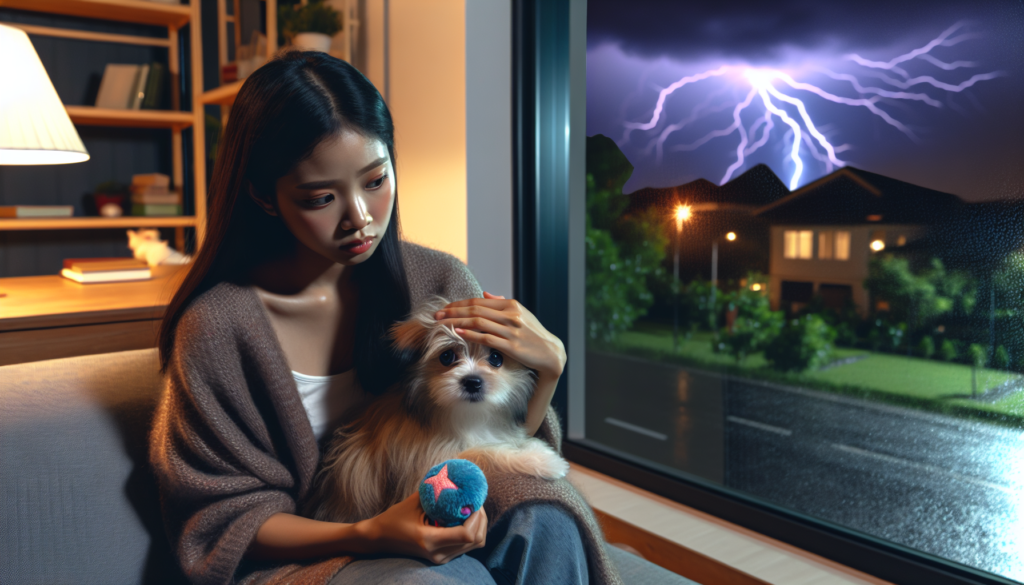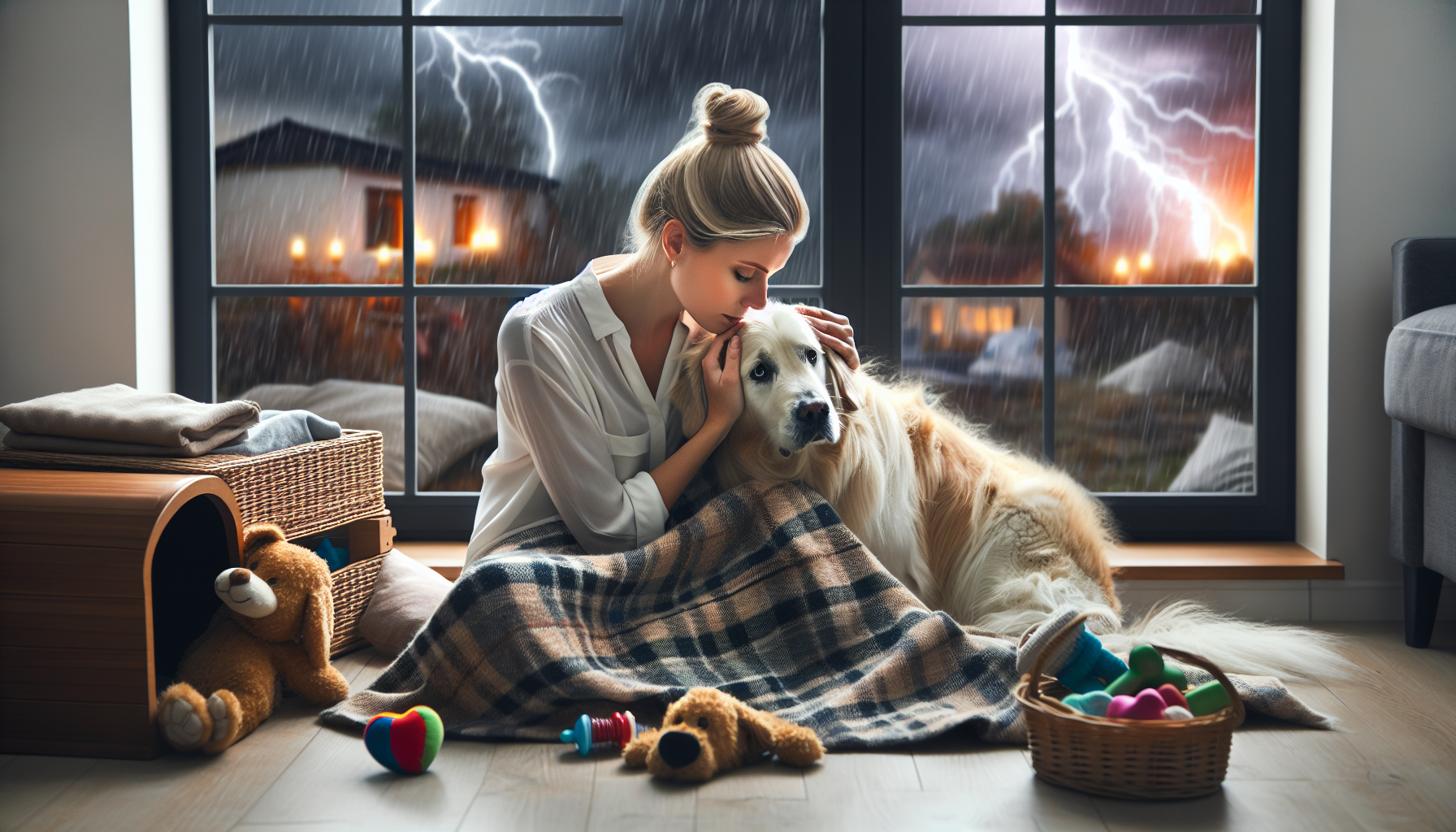Dealing with a dog’s fear of thunder and fireworks can be a challenging and distressing experience for both you and your furry companion. However, there are effective strategies and techniques that can help alleviate their anxiety and keep them calm during these overwhelming situations. By understanding the underlying causes of their fear and implementing positive reinforcement training, you can create a safe and reassuring environment for your dog, allowing them to feel more secure and at ease during thunderstorms and firework displays.
Understanding the Causes of Fear
Loud Noises
One of the main causes of fear in dogs, particularly when it comes to thunderstorms or fireworks, is loud noises. Dogs have sensitive hearing, and sudden loud noises can be overwhelming for them. The booming sound of thunder or the crackling of fireworks can trigger a fear response in dogs, causing them to exhibit signs of anxiety and distress.
Unpredictability
Another factor that contributes to a dog’s fear of thunder and fireworks is the unpredictable nature of these events. Thunderstorms and fireworks displays can occur out of nowhere, catching dogs off guard and making them feel vulnerable. This lack of control over their environment can intensify their fear and make it difficult for them to relax during these situations.
Negative Conditioning
It’s important to note that fear of thunder and fireworks can also be a learned response. If a dog has had a negative experience during a thunderstorm or fireworks display, such as getting startled or hurt, they may develop a fear or phobia towards these events. This negative conditioning can be challenging to overcome and may require specialized training and behavior modification techniques.
Recognizing Signs of Fear
Trembling
One of the most common signs of fear in dogs is trembling. When a dog is afraid, their body may shake uncontrollably as a physiological response to the fear-inducing stimuli. If you notice your dog trembling during a thunderstorm or fireworks, it’s a clear indication that they are experiencing fear and anxiety.
Panting
Excessive panting is another sign that your dog is fearful. Panting is a way for dogs to regulate their body temperature, but it can also be a response to stress and fear. If your dog starts panting heavily during a thunderstorm or fireworks, it’s a sign that they are feeling anxious and trying to cope with the situation.
Hiding or Seeking Comfort
When dogs are scared, they often seek out safe spaces to hide or look for comfort from their owners. If your dog starts hiding under furniture, behind curtains, or in their crate during thunderstorms or fireworks, it’s a clear indication that they are feeling afraid. Some dogs may also seek physical contact and may try to stay close to their owners for reassurance and comfort.

Creating a Safe Space
Choosing a Quiet Location
Creating a safe space for your dog during thunderstorms or fireworks is essential. Choose a quiet area in your home where your dog feels secure and comfortable. Ideally, this should be a room that is insulated from outside noise and has minimal windows. A basement or an interior room without windows can work well as a designated safe space for your dog.
Providing a Cozy Den
Within the chosen quiet location, provide your dog with a cozy den-like area. This can be a crate, a covered dog bed, or even a blanket fort. The idea is to create a small, confined space where your dog can feel protected and secure. Add soft bedding and familiar items such as their favorite toys or blankets to make the den even more comforting.
Using Adaptable Crates
If you prefer using a crate as your dog’s safe space, consider using an adaptable crate that can block out noise and create a more secure environment. There are crates available on the market that have noise-reducing features, such as sound-dampening materials or special crate covers. These can help minimize the impact of loud noises during thunderstorms or fireworks.
Noise-Masking Techniques
Background Music or TV
To help mask the sounds of thunder and fireworks, you can play soothing background music or turn on the TV in your dog’s safe space. Soft classical music or calming nature sounds can help create a more relaxing environment for your dog. The continuous background noise can help drown out the sudden bursts of thunder or the booms of fireworks, reducing their impact on your dog’s anxiety.
White Noise or Sound Machines
White noise machines or sound machines can also be effective in masking the sounds of thunderstorms or fireworks. These machines emit a constant noise, such as the sound of ocean waves or rain falling, which can help to distract your dog from the loud noises outside. Place the sound machine near your dog’s safe space to provide a calming and soothing ambiance.
Smart Speakers and Ambient Sounds Apps
If you have a smart speaker or a smartphone, you can use apps or specific commands to play ambient sounds that can help mask the sounds of thunder and fireworks. There are apps available that offer a variety of soothing sounds, from gentle rain to chirping birds. Utilizing these technological resources can contribute to creating a more tranquil environment for your dog.

Desensitization and Counter Conditioning
Gradual Exposure to Thunder or Fireworks Sounds
Desensitization and counter conditioning techniques can be effective in helping your dog overcome their fear of thunderstorms or fireworks. The key is to expose your dog to the fear-inducing sounds gradually, in a controlled and positive way. Start by playing low-volume recordings of thunder or fireworks sounds while engaging in pleasurable activities with your dog, such as playing or giving treats. Slowly increase the volume over time as your dog becomes more comfortable and relaxed.
Positive Reinforcement and Treats
Positive reinforcement is crucial when desensitizing your dog to thunder and fireworks sounds. Whenever your dog shows calm or relaxed behavior during exposure to these sounds, reward them with treats, praise, and affection. This positive reinforcement helps to associate the presence of the fear-inducing sounds with positive experiences, gradually reducing their fear and anxiety.
Professional Help
If your dog’s fear of thunderstorms or fireworks persists despite your best efforts, it may be beneficial to seek professional assistance. A certified animal behaviorist or a qualified dog trainer experienced in fear-related issues can provide specialized guidance and support. They can design a tailored desensitization and counter conditioning program to help your dog overcome their fear and build confidence.
Behavior Modification Techniques
Thundershirts or Anxiety Wraps
Thundershirts or anxiety wraps are specially designed garments that provide gentle, constant pressure to help calm anxious dogs. The pressure applied by these garments can have a soothing effect on dogs, similar to the feeling of being swaddled. Thundershirts and anxiety wraps can be particularly useful during thunderstorms or fireworks, as they provide a sense of security and comfort for your dog.
Calming Supplements or Medications
In some cases, calming supplements or medications may be recommended to help manage your dog’s fear and anxiety. These supplements often contain natural ingredients such as chamomile or lavender, which have calming properties. However, it’s crucial to consult with your veterinarian before giving your dog any supplements or medications, as they can have potential side effects and may interact with other medications.
Aromatherapy and Pheromone Sprays
Aromatherapy and pheromone sprays can help create a calming environment for your dog. Lavender or chamomile essential oils, when diffused or applied topically in a diluted form, can have a soothing effect on dogs. Additionally, synthetic pheromone sprays, such as dog-appeasing pheromone (DAP), can mimic the calming effects of maternal dog pheromones and help alleviate anxiety. It’s important to use these products according to the manufacturer’s instructions and consult with your veterinarian if needed.
Preparing for Thunderstorms or Fireworks
Weather Forecast Monitoring
Stay informed about the weather forecast to anticipate upcoming thunderstorms or fireworks displays. By knowing when these events are likely to occur, you can take preemptive measures to prepare your dog and create a safe environment. Websites, smartphone apps, or local news channels can provide accurate and up-to-date weather information.
Creating a Calming Routine
Establishing a calming routine before thunderstorms or fireworks can help prepare your dog mentally and physically for these events. Engage in activities that promote relaxation, such as a calming massage, gentle play, or training exercises focusing on positive reinforcement. By incorporating these activities into a routine, your dog will associate them with a sense of calmness and relaxation, helping to mitigate their fear response.
Ensuring Safety Measures
During thunderstorms or fireworks, it’s crucial to ensure the safety of your dog. Close all windows and draw curtains or blinds to minimize noise and visual stimuli. Secure doors and gates to prevent your dog from fleeing outside in a state of panic. If your dog tends to hide in specific areas, make sure those spaces are safe and free from any hazards. Consider using identification tags or microchipping your dog to increase the chances of a safe return if they do manage to escape.
Safe Handling During Stressful Situations
Avoid Punishment or Coddling
When your dog is scared during thunderstorms or fireworks, it’s important to avoid punishing or scolding them. Punishment can exacerbate their fear and lead to further anxiety-related behaviors. Instead, provide reassurance and comfort in a calm and soothing manner. However, be cautious not to reinforce their fear by coddling or overly comforting them, as this may inadvertently reinforce their anxious behavior.
Maintain a Calm Demeanor
Dogs can pick up on their owners’ emotions and energy, so it’s crucial to remain calm and composed during stressful situations. Your dog looks to you for guidance and reassurance, and if you appear anxious or agitated, it can amplify their fear. Speak in a soothing tone, use gentle touches, and project an image of calmness to help your dog feel more secure.
Distraction and Engaging Activities
During thunderstorms or fireworks, distract your dog from their fear by engaging them in enjoyable activities. Play with their favorite toys, practice obedience commands, or provide interactive food puzzles to keep their mind occupied. By redirecting their focus onto positive experiences, you can help shift their attention away from the fear-inducing stimuli.
Professional Assistance and Training
Consulting a Veterinarian or Animal Behaviorist
If your dog’s fear of thunderstorms or fireworks persists or worsens over time, it’s advisable to consult with a veterinarian or certified animal behaviorist. These professionals have extensive knowledge and experience in handling fear-related issues in dogs. They can assess your dog’s specific situation, provide expert guidance, and potentially recommend additional treatments, such as medication, that could support your dog’s well-being.
Qualified Dog Trainers
Qualified dog trainers who specialize in fear-related behaviors can also be a valuable resource in helping your dog overcome their fear of thunderstorms or fireworks. They can design customized training programs and exercises that address your dog’s specific needs. With their expertise and guidance, you can work together to build your dog’s confidence and reduce their fear response.
Therapeutic Interventions
In severe cases of fear or phobia, therapeutic interventions may be necessary. Techniques such as desensitization and counter conditioning, cognitive-behavioral therapy, or even virtual reality exposure therapy can be used to help your dog overcome their fear. These interventions should be conducted under the supervision of a qualified professional who specializes in animal behavior.
Long-term Management and Prevention Strategies
Consistency and Positive Reinforcement
Consistency is key when managing and preventing fear-related behaviors in dogs. Continuously reinforce positive behaviors and reward your dog for remaining calm and relaxed during thunderstorms or fireworks. By consistently providing positive experiences and rewards, you help strengthen their resilience and reduce their fear response over time.
Continued Exposure and Adaptation
Continued exposure to thunderstorms or fireworks, in a controlled and gradual manner, can contribute to desensitizing your dog. As your dog becomes more familiar with these sounds and experiences, their fear response may diminish. However, it’s crucial to ensure that the exposure is always accompanied by positive reinforcement and a sense of safety.
Regular Exercise and Mental Stimulation
Regular exercise and mental stimulation are essential for overall well-being and can also help manage fear-related behaviors in dogs. Engage in daily physical activities such as walks, runs, or play sessions to burn off excess energy and promote relaxation. Additionally, provide mental stimulation through puzzle toys, obedience training, or interactive games to keep your dog’s mind engaged and distracted from fearful stimuli.
By understanding the causes of fear, recognizing the signs, and implementing strategies to create a safe and calming environment, you can help your dog overcome their fear of thunderstorms and fireworks. With patience, consistency, and professional assistance if needed, you can ensure that your furry friend feels secure and comfortable during these potentially anxiety-inducing events. Remember, your friendly presence and support play an integral role in helping your dog conquer their fears and live a happier and more fulfilling life.

